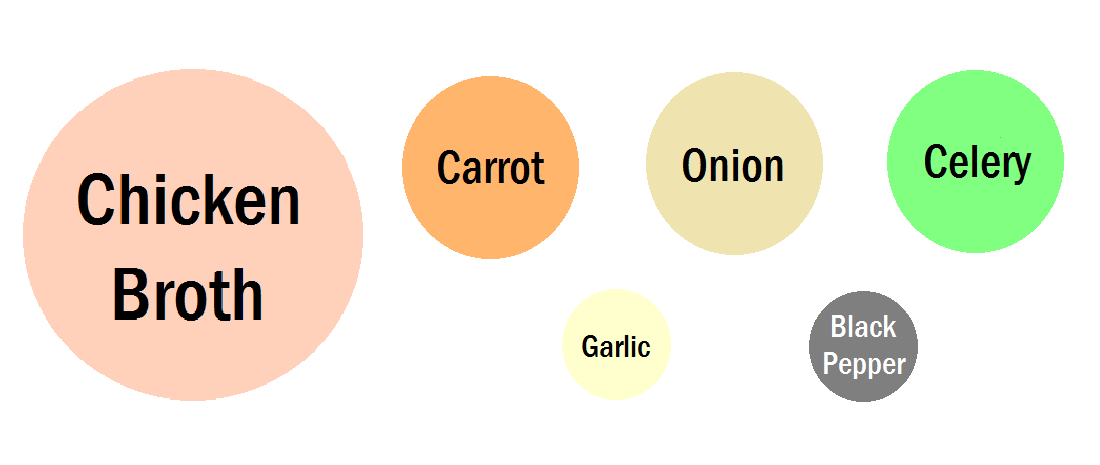- Mirepoix
- Cajun Holy Trinity
- Sofrito
- Chinese Trinity
- Autumn Spice Blend
- Classic Meat Brine
- Bonus: Cheater Chicken Stock Recipe
From these bases, you can build countless dishes and experiment with new recipes and creations. So read on, make some mental notes, and soon all these bases will belong to you. Let's cook.
Mirepoix (Meer-pwah) is a classic French mixture that serves as the basis for countless soups, stews, and sauces. The combination of celery, onion, and carrot provides the rich, balanced flavour that makes French cuisine so well known and delicious. Traditionally, the ratio is 2 parts onion to 1 part each of celery and carrot, all chopped into small cubes. The mix is then typically sauteed until soft and then built upon. The 2:1:1 ratio is not a hard rule either; I have seen this vary though so don't be afraid to adjust to your taste. That goes for all of these mixes.
Feeling Cajun or wanting to evoque the "Laissez les bon temps rouler" spirit of New Orleans? Build a dish on the basis of onion, celery, and green bell peppers. The Cajun cousin to the French Mirepoix, this finely chopped mixture serves as the base for many dishes, most notably the Cajun classic: gumbo. The Holy Trinity's similarity to mirepoix stems from the French connection they both share, as Cajun cuisine is based off of French roots. Learn more here.
A bright flavor base of Spanish and Latin American cuisine, Sofrito is a mixture of finely chopped onion, peppers, garlic, and a little cilantro sauteed until very soft in a generous amount of olive oil. The base itself can be used as a pretty tasty sauce on its own, but it also serves as the base of many Latin American rice, vegetable, and meat dishes. While sofritos can and do vary widely in spice levels, it's base ingredients share common elements. You are the master of your own sofrito so experiment until you reach a combination you like.
While Chinese cuisine varies widely - Shanghainese, Szechuan, Sichuan, and Cantonese just to name a few, some common flavours that you will come across find their roots in a combination of green onion (scallion), garlic, and fresh ginger. So common are these ingredients that many now are starting to refer to them as the Chinese Trinity, a play on the Holy Trinity of Cajun Cuisine. The ginger and garlic are typically cut into thin strips while the green onion can be chopped small or left in larger 1-inch pieces.
This is the only real full spice blend on this list. Winter weather makes people want to cozy up next to a fire with the warmest blanket. So what flavors best capture that moment? Warm Cinnamon, Complex Nutmeg, and spicy ginger, that's what. Mix this blend into cake batter, cookies, and other baked goods or shake on top of hot cocoa.
Yields: Brine for 1 chicken or equal amount of meat.
Just in time for Thanksgiving and large holiday meals, a brine is a highly seasoned saltwater solution you let poultry and other meats soak in for hours. Through a complex process best explained below by Alton Brown, it helps ensure your turkey/chicken/pork tenderloin/whathaveyou is perfectly seasoned and unfathomably juicy.
Simply dissolve the salt and sugar in the water and add the peppercorns and meat. Soak for 4-6 hours, adding ice as necessary, until ready to cook. Scale recipe up and down to just cover the meat in a large bowl or tub.
Well, yeah. You caught me. But there is a reason why chicken stock is included here. Look at any savory dish recipe or watch any cooking show, and you will notice water, unless it's for cooking pasta, is typically not used as the base for a sauce, soup, stew, or otherwise. Usually it's some kind of broth or stock. Deglaze a pan after searing some nice meat? Broth. Making a nice pot of soup? Add water? Nope: broth or stock. You get the idea.
So what is the difference between chicken stock and chicken broth? Well, nothing too much. It comes down to the meat and bones used. Stocks are typically made with more bones than broths. This means that stocks tend to be a little more full flavored and "rich" feeling on the tongue. Stocks also typically take longer to make than broths since the bones need to be simmered longer - typically upwards of 4 hours.
So why do chefs and cooks of all levels seem to love this stuff? Well, while water is an amazing solvent and can easily bring the moisture, it tastes like, well, nothing. Why keep things bland when you can add flavor and richness? That is why chefs will flirt and throw compliments at broths and stocks as if it were the most beautiful person in the room.
So, you want a recipe for homemade chicken stock you say but you don't want to have to wait all day for a chicken carcass to simmer? Well you're in luck. Here’s a cheater way to get 80% of the way to stock goodness with only 10% of the work, and it's courtesy of canned chicken broth and the good 'ol mirepoix.
Makes 2 Quarts
Ingredients
2 Quarts of chicken broth (Two 32 fl. oz. cartons or 4 standard cans)
1 carrot chopped fine
2 stalks celery chopped fine
1/2 medium onion, chopped fine
1 garlic clove cut in half
6 whole peppercorns
Directions
1. In a large saucepan or pot, bring the broth and all the other ingredients up to a simmer over medium heat. Lid on please!
2. When a simmer is achieved, turn the heat to low and let simmer for 20 minutes.
3. When ready, strain the enriched broth through a collander into another pot or very large bowl. Use immediately or cool and refrigerate until needed.








